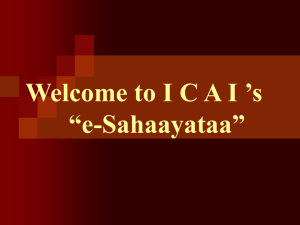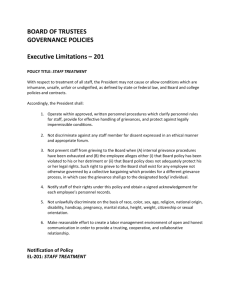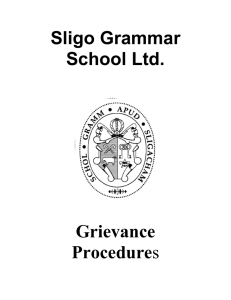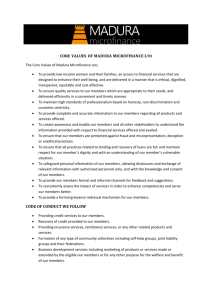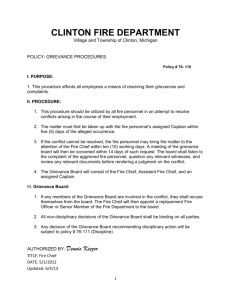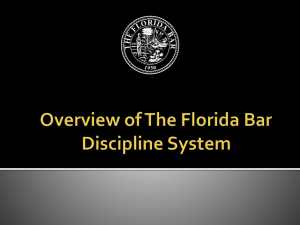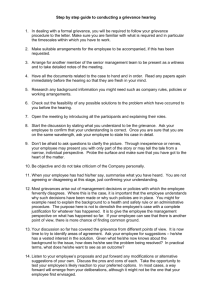19 How to Handle a Complaint, Grievance or
advertisement
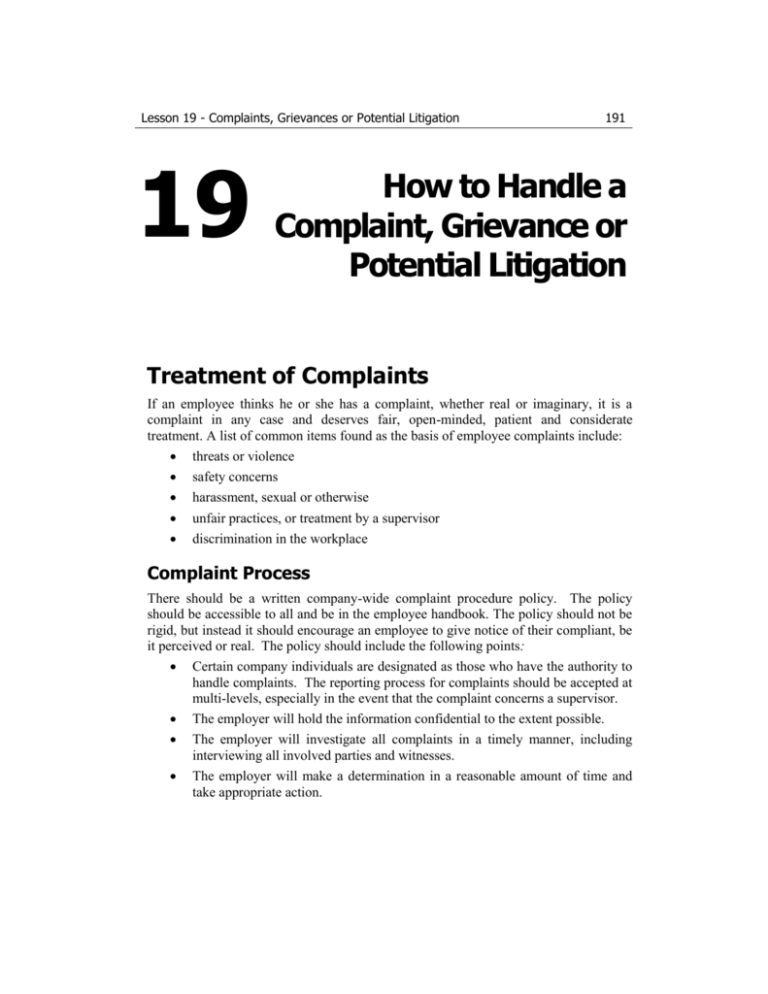
Lesson 19 - Complaints, Grievances or Potential Litigation 19 191 How to Handle a Complaint, Grievance or Potential Litigation Treatment of Complaints If an employee thinks he or she has a complaint, whether real or imaginary, it is a complaint in any case and deserves fair, open-minded, patient and considerate treatment. A list of common items found as the basis of employee complaints include: threats or violence safety concerns harassment, sexual or otherwise unfair practices, or treatment by a supervisor discrimination in the workplace Complaint Process There should be a written company-wide complaint procedure policy. The policy should be accessible to all and be in the employee handbook. The policy should not be rigid, but instead it should encourage an employee to give notice of their compliant, be it perceived or real. The policy should include the following points: Certain company individuals are designated as those who have the authority to handle complaints. The reporting process for complaints should be accepted at multi-levels, especially in the event that the complaint concerns a supervisor. The employer will hold the information confidential to the extent possible. The employer will investigate all complaints in a timely manner, including interviewing all involved parties and witnesses. The employer will make a determination in a reasonable amount of time and take appropriate action. Lesson 19 - Complaints, Grievances or Potential Litigation 192 This allows for an effective company complaint process. When an employer lays down these ground rules, employees know there is a process in place and that their complaint will be heard. Employees may feel better about fair treatment, which could result in fewer frivolous or redundant complaints. A simple compliant form can be the instrument of origin. Treatment of Grievances Do not make the mistake of believing that grievances only take place where there are unions or only in large companies. Every employee should know that he or she has the right to make a grievance, and that the organization and its procedures recognizes this right. Whether the grievance is justified or not, the employee should receive a timely decision and explanation for the basis of the company’s answer. The Grievance Process Handling grievances is a tricky task. While larger companies usually have a grievance procedure in place, smaller firms usually manage grievance situations on a reactive basis. Regardless of which category you company falls into, the suggestions listed below will make your handling of the grievance process easier: The person who is the immediate supervisor of the employee should be the first person to whom the grievance is presented (unless that grievance is against that supervisor). Grievance procedures must allow for employees to appeal and take their grievances to a higher level, if the original complaint is ignored, neglected, unfairly handled or if the immediate supervisor refused to acknowledge the grievance. Every supervisor should be informed that it is an essential part of the job to properly handle the grievances from their employees, and that the organization holds its supervisor responsible for doing so. When dealing with an employee’s complaint or grievance, the supervisor should discuss it in a friendly manner. The supervisor should not be argumentative, antagonistic, or defensive. He or she should avoid implying any threat of retaliation against the employee. When employees have complaints or grievances, the supervisor should listen fully to the employee’s viewpoint, reserve judgment, discuss the grievance in private, and take prompt action on the problem, if possible. If the supervisor or organization is at fault, the mistake should be openly admitted and prompt action should be taken to correct it. Lesson 19 - Complaints, Grievances or Potential Litigation 193 As a supervisor, do not pass the buck in accepting a grievance, in acting on a grievance, in explaining the decision on the grievance, or rejecting a grievance. Only if the supervisor lacks the authority to handle the grievance, should they turn the matter over to a higher authority. Treatment of Litigation When litigation becomes a reality every employer gets that sick feeling. This feeling can’t be helped. It goes without saying that you will need the services of a labor attorney. Compile All Related Documents The first thing to do is to compile and review all of the employee records of those involved. The review should include the application, screening results, performance evaluations and any complaints or disciplinary files. Realize that these documents may be part, if not the sole basis for, the defense. When the company’s policies and procedures are compared to the records of the involved employee, often a clear picture emerges. Whether you are right or wrong, and to what degree, may be self-evident once this evaluation is completed. However, if an employer does not have good hiring procedures, policies, posting and record keeping, it is time to start preparing to do some back peddling. Look For Prior History Employers who have been in business for several years, or have some history of dealing with such problems, should be able to rely upon past practices as a means to support their side in litigation disputes. For example, if a company has a history of terminating “other” employees who violated the same specific company rules, then the company has established “practice.” As long as this termination practice is legal, per an attorney, it can be used as proof for a defense. This is especially important in cases when the litigant claims discrimination because of race or sex. Involve Your Insurance Carrier Finally, always examine your business insurance policy and call your insurance agent. You may have coverage, depending on the particulars. Coverage may even include an attorney. Remember…. If you maintain good records you are already ahead of the game. Lesson 19 - Complaints, Grievances or Potential Litigation 194 Consider Arbitration Agreements Today, many employers are requiring workers to agree in advance to settle any employment-related disputes in arbitration. This avoids prolonged litigation and excessive costs. This trend was enhanced with a recent Supreme Court decision (Circuit City Stores vs. Adams, March 21, 2001). The US Supreme Court, in 5-4 decision, ruled that companies can insist that workplace disputes go to arbitration rather than to court. The ruling also stipulated that the Federal Arbitration Act covered employment contracts. Lesson Summary: Whether the action is a complaint or a grievance, it most be taken seriously. Establish a company policy to handle complaints and grievances. Post the complaint policy and include it in the employee manual. The ongoing issue of having policies in place and documentation at hand is important to insure against the threat of litigation. Check with your insurance provider for coverage. Recommended Resources: http://www.healthwellexchange.com/nfm-online/nfm_backs/Jun_99/grievances.cfm This is a well-written article entitled Working Through Employee Grievances, by Carolee Colter. http://www.shrm.org/channels The Society for Human Resource Management site has some excellent free access articles. Click on the Employee Relations Channel.
